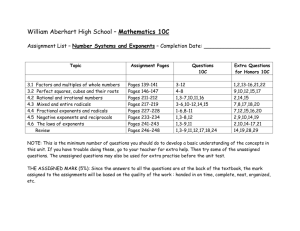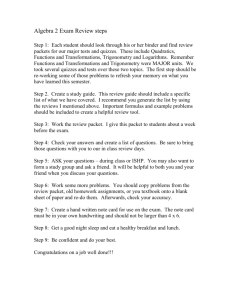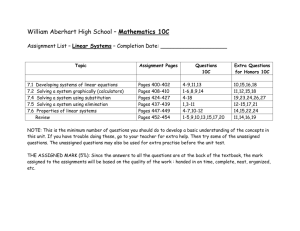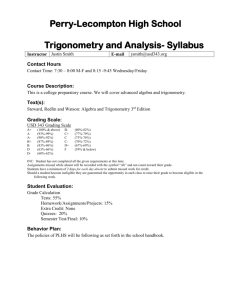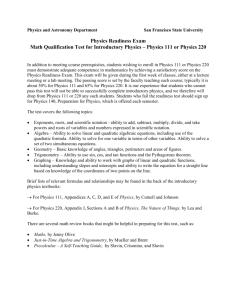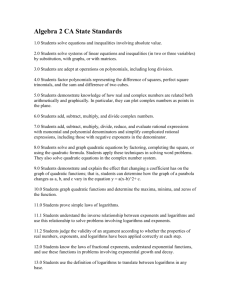File - KL Johns' Portfolio
advertisement
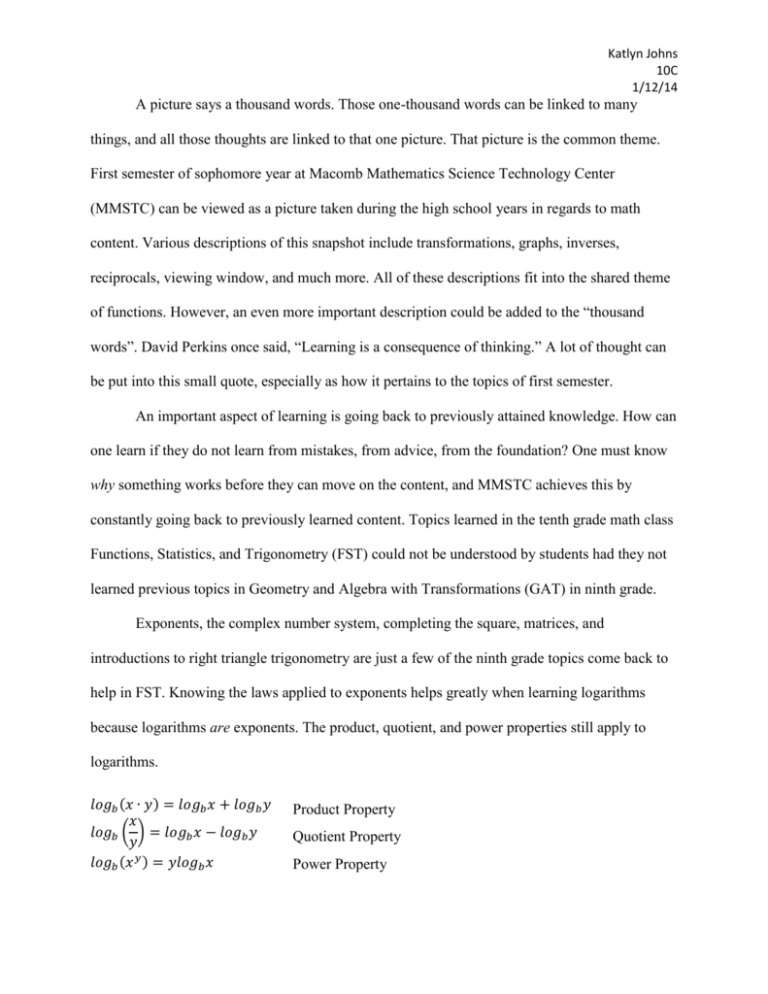
Katlyn Johns 10C 1/12/14 A picture says a thousand words. Those one-thousand words can be linked to many things, and all those thoughts are linked to that one picture. That picture is the common theme. First semester of sophomore year at Macomb Mathematics Science Technology Center (MMSTC) can be viewed as a picture taken during the high school years in regards to math content. Various descriptions of this snapshot include transformations, graphs, inverses, reciprocals, viewing window, and much more. All of these descriptions fit into the shared theme of functions. However, an even more important description could be added to the “thousand words”. David Perkins once said, “Learning is a consequence of thinking.” A lot of thought can be put into this small quote, especially as how it pertains to the topics of first semester. An important aspect of learning is going back to previously attained knowledge. How can one learn if they do not learn from mistakes, from advice, from the foundation? One must know why something works before they can move on the content, and MMSTC achieves this by constantly going back to previously learned content. Topics learned in the tenth grade math class Functions, Statistics, and Trigonometry (FST) could not be understood by students had they not learned previous topics in Geometry and Algebra with Transformations (GAT) in ninth grade. Exponents, the complex number system, completing the square, matrices, and introductions to right triangle trigonometry are just a few of the ninth grade topics come back to help in FST. Knowing the laws applied to exponents helps greatly when learning logarithms because logarithms are exponents. The product, quotient, and power properties still apply to logarithms. 𝑙𝑜𝑔𝑏 (𝑥 ∙ 𝑦) = 𝑙𝑜𝑔𝑏 𝑥 + 𝑙𝑜𝑔𝑏 𝑦 𝑥 𝑙𝑜𝑔𝑏 ( ) = 𝑙𝑜𝑔𝑏 𝑥 − 𝑙𝑜𝑔𝑏 𝑦 𝑦 𝑙𝑜𝑔𝑏 (𝑥 𝑦 ) = 𝑦𝑙𝑜𝑔𝑏 𝑥 Product Property Quotient Property Power Property Katlyn Johns 10C 1/12/14 The complex number system is also useful in naming the domain and range of functions being learned. Completing the square, associated with the quadratic equation and formula, can be used to solve a new model, the falling bodies model. The falling bodies model, associated with physics, can be used with a quadratic model to find when objects hit the ground at a certain velocity. Matrices are used to find a non-regression model for a quadratic equation. Three points are used to make three hypothetical equations and this is inserted into a three by three matrix. The inverse of this matrix is multiplied by the outcome values of the S i n e three points to find the a, b, and c value of the equation. Learning the meaning of each of the trigonometric O p p o s i t e functions is useful in learning the reciprocal H y p o t e n u s e C o s i n e A d j a c e n t H y p o t e n u s e T a n g e n t O p p o s i t e trigonometry functions. Both the original and reciprocal trigonometry functions are based off a right triangle. At right are the values of the original functions. These values are then reversed for the reciprocal functions. Another aspect of thinking is allowing one to discover patterns. A common pattern in this stage of math is the unit circle. Just knowing the first quadrant can allow the values of the other major points to be found. This is because the most commonly used radian and degree measures are at multiples of 30°, 45°, and 60°. These values are all dividends of 360° (one revolution) so their counterparts can be found around the circle. Going back to the idea of revisiting previously learned content, this can also be applied to connecting math concepts to other topics. An exponential function, for example, can be used to study continually rising populations, even though in nature, this is not a likely model. As A d j a c e n t Katlyn Johns 10C 1/12/14 mentioned previously, the falling bodies model, discovered by Sir Isaac Newton, is used to express the relationship between acceleration due to gravity, velocity, and initial height of the object. Had he not thought about this connection, this would be an unknown fact that is plainly accepted as true. Dimensional analysis, another connection between math and science, was originally learned in chemistry as a way to convert between different units. Later on, this concept was used in math to convert between degrees and radians. They are related in that they both use conversion factors, again the work of one’s thoughts. In the process of learning new parent functions, particularly more challenging ones, the key is knowing their qualities. Functions each have their own domain, range, and passing coordinates, and knowing why they are what they are makes them all the easier to graph. Knowing why their parts act as they do is the first step in learning them. For example, the inverse trigonometry functions are restricted and pass through specific points. They are restricted because, otherwise, they would not be functions. An inverse graph of a function is all the original data points, but the input and output are switched. A function cannot have more than one output for each input, and when sine, cosine, or tangent is inverted, this is not true. That is why the inverses of the trigonometry functions are restricted to where there is only one output for each input. One cannot learn a new function and what it looks like until they can completely understand why it looks the way it does. Not knowing its qualities such as domain, range, and passing points means struggling. “Learning is a consequence of thinking”. So much power and thought come from this quote. It speaks out as one cannot learn without thinking, therefore we cannot learn something new unless we dig deep. All that has been learned in the first semester of FST has come from thinking, whether it has been making connections to other topics, discovering patterns, or Katlyn Johns 10C 1/12/14 revisiting what we already know. These aspects have impacted all the students of MMSTC to learn what is taught and whatever is thrown their way. Katlyn Johns 10C 1/12/14 Bibliography: Instruments, Texas. "TI-Nspire." Texas Instruments, 2006-2013.
